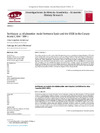Identificador persistente para citar o vincular este elemento:
https://accedacris.ulpgc.es/handle/10553/107454
| Title: | Sovhispan: a collaboration model between Spain and the USSR in the Canary Islands (1967-1991) | Other Titles: | Sovhispan: un modelo de colaboración entre España y la URSS en las Islas Canarias (1967-1991) | Authors: | Yányshev Nésterova, Irina De Luxán Meléndez, Santiago |
UNESCO Clasification: | 550606 Historia de la economía | Keywords: | Soviet-Spanish bilateral relations Soviet fishing fleet Canary Islands Soviet joint-ventures Relaciones bilaterales hispano-soviéticas, et al |
Issue Date: | 2021 | Journal: | Investigaciones de Historia Economica | Abstract: | El artículo contribuye al estudio de la joint venture Sovhispán, creada en las Islas Canarias en 1971 por capital soviético y capital español (público y privado), en un marco político bilateral carente de relaciones diplomáticas. Sovhispán se dedicaba a la prestación de servicios de avituallamiento a los buques pesqueros soviéticos que arribaban en los puertos canarios desde los fines de los años sesenta hasta 1991. En primer lugar, Sovhispan fue la fórmula más adecuada para la colaboración entre ambos países, especialmente antes del reconocimiento diplomático mutuo en 1977. En segundo lugar, puede considerarse un modelo de empresa mixta soviética en el extranjero, creada tanto para obtener tecnología occidental como para acceder a los recursos pesqueros de terceros países. Por último, la llegada de la flota pesquera soviética, una de las más potentes del mundo, coincidió con los intentos de industrialización del archipiélago e influyó positivamente al desarrollo económico de las Islas Canarias The article contributes to the study of the Sovhispan joint venture, created in the Canary Islands in 1971, with Soviet and Spanish capital (public and private one), in a bilateral political framework devoid of diplomatic relations. Sovhispan was dedicated to the provision of victualling services to the Soviet fishing vessels that arrived in the Canary Islands ports, from the late 1960’s to 1991. In the first place, Sovhispan was the most suita-ble formula for collaboration between both countries, especially before the mutual diplomatic recognition in 1977. Secondly, it can be considered a model of a mixed Soviet company created overseas, both to obtain Western technology and to access the fishing resources of third countries. Finally, the arrival of the Soviet fishing fleet, one of the most powerful in the world, coincided with the attempts to industrialize the archipelago and positively influenced the economic development of the Canary Islands. |
URI: | https://accedacris.ulpgc.es/handle/10553/107454 | ISSN: | 1698-6989 | Source: | Investigaciones de Historia Económica = Economic History Research [ISSN 1698-6989], v. 17 (3), p. 1-13 | URL: | http://dialnet.unirioja.es/servlet/articulo?codigo=7937651 |
| Appears in Collections: | Artículos |
Page view(s)
144
checked on Apr 20, 2024
Download(s)
67
checked on Apr 20, 2024
Google ScholarTM
Check
Share
Export metadata
Items in accedaCRIS are protected by copyright, with all rights reserved, unless otherwise indicated.
